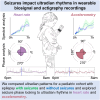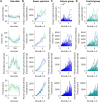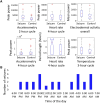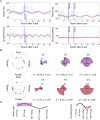Ultradian rhythms in accelerometric and autonomic data vary based on seizure occurrence in paediatric epilepsy patients
- PMID: 38454964
- PMCID: PMC10919479
- DOI: 10.1093/braincomms/fcae034
Ultradian rhythms in accelerometric and autonomic data vary based on seizure occurrence in paediatric epilepsy patients
Abstract
Ultradian rhythms are physiological oscillations that resonate with period lengths shorter than 24 hours. This study examined the expression of ultradian rhythms in patients with epilepsy, a disease defined by an enduring seizure risk that may vary cyclically. Using a wearable device, we recorded heart rate, body temperature, electrodermal activity and limb accelerometry in patients admitted to the paediatric epilepsy monitoring unit. In our case-control design, we included recordings from 29 patients with tonic-clonic seizures and 29 non-seizing controls. We spectrally decomposed each signal to identify cycle lengths of interest and compared average spectral power- and period-related markers between groups. Additionally, we related seizure occurrence to the phase of ultradian rhythm in patients with recorded seizures. We observed prominent 2- and 4-hour-long ultradian rhythms of accelerometry, as well as 4-hour-long oscillations in heart rate. Patients with seizures displayed a higher peak power in the 2-hour accelerometry rhythm (U = 287, P = 0.038) and a period-lengthened 4-hour heart rate rhythm (U = 291.5, P = 0.037). Those that seized also displayed greater mean rhythmic electrodermal activity (U = 261; P = 0.013). Most seizures occurred during the falling-to-trough quarter phase of accelerometric rhythms (13 out of 27, χ2 = 8.41, P = 0.038). Fluctuations in seizure risk or the occurrence of seizures may interrelate with ultradian rhythms of movement and autonomic function. Longitudinal assessments of ultradian patterns in larger patient samples may enable us to understand how such rhythms may improve the temporal precision of seizure forecasting models.
Keywords: accelerometry; autonomic activity; cyclic patterns; epilepsy; paediatric patients.
© The Author(s) 2024. Published by Oxford University Press on behalf of the Guarantors of Brain.
Conflict of interest statement
T.L. is part of patent applications to detect and predict clinical outcomes and to manage, diagnose and treat neurological conditions, epilepsy and seizures. T.L. has received device donations from various companies, including Empatica, and has received research support from Empatica in the past. S.V. is part of a patent application covering technology for seizure forecasting. Other authors report no other relevant disclosures.
Figures





Similar articles
-
Twenty-four-hour patterns in electrodermal activity recordings of patients with and without epileptic seizures.Epilepsia. 2021 Apr;62(4):960-972. doi: 10.1111/epi.16843. Epub 2021 Feb 23. Epilepsia. 2021. PMID: 33619751
-
Explainable AI for wearable seizure logging: Impact of data quality, patient age, and antiseizure medication on performance.Seizure. 2023 Aug;110:99-108. doi: 10.1016/j.seizure.2023.06.002. Epub 2023 Jun 8. Seizure. 2023. PMID: 37336056
-
Autonomic control of ultradian and circadian rhythms of blood pressure, heart rate, and baroreflex sensitivity in spontaneously hypertensive rats.J Hypertens. 1997 Apr;15(4):401-10. doi: 10.1097/00004872-199715040-00011. J Hypertens. 1997. PMID: 9211175
-
Movement-based seizure detection.Epilepsia. 2018 Jun;59 Suppl 1:30-35. doi: 10.1111/epi.14053. Epub 2018 Apr 9. Epilepsia. 2018. PMID: 29635767 Review.
-
Seizure forecasting and cyclic control of seizures.Epilepsia. 2021 Feb;62 Suppl 1:S2-S14. doi: 10.1111/epi.16541. Epub 2020 Jul 26. Epilepsia. 2021. PMID: 32712968 Review.
References
-
- Freestone DR, Karoly PJ, Cook MJ. A forward-looking review of seizure prediction. Curr Opin Neurol. 2017; 30(2):167–173. - PubMed
-
- Cook MJ, O’Brien TJ, Berkovic SF, et al. . Prediction of seizure likelihood with a long-term, implanted seizure advisory system in patients with drug-resistant epilepsy: A first-in-man study. Lancet Neurol. 2013; 12(6):563–571. - PubMed
-
- Geller EB. Responsive neurostimulation: Review of clinical trials and insights into focal epilepsy. Epilepsy Behav. 2018; 88:11–20. - PubMed
LinkOut - more resources
Full Text Sources
